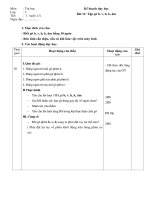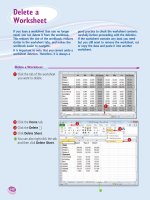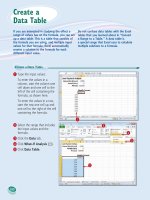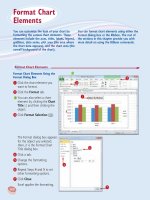Tài liệu Constituent Structure - Part 3 doc
Bạn đang xem bản rút gọn của tài liệu. Xem và tải ngay bản đầy đủ của tài liệu tại đây (93.39 KB, 10 trang )
This page intentionally left blank
Part 1
Preliminaries
This page intentionally left blank
1
Introduction
1.1 What this book is about
The study of phrase or constituent structure explores the combination
of words into phrases and sentences. Constituent structure provides
the roadmap that determines which words can be combined with
which other words. This book is about the many, and varied, attempts
to explain how word combination occurs.
An old, but important, observation about sentences is that they are
not merely a linear string of words. There appears, even at an intuitive
level, to be some organization that links some words more closely
together than others. Take, for example, the sentence in (1):
(1) My cat eats at really fancy restaurants.
In terms of interpretation, the relationship between really and fancy
seems to be closer than that between eats and at. The word really tells us
about how fancy the restaurants are, whereas the semantic relationship
between eat and at seems to be mediated by the more distant words
fancy and restaurants—this despite the fact that in terms of linear order
the relationship between eat at and really fancy is identical—in each
case the words are adjacent. In the structuralist tradition, whether
instantiated in a formalist or functionalist framework, this kind of
closeness is indicated by ‘‘phrase’’ (or ‘‘constituent’’) structure. The
graphic representation of phrase structure has about as many variants
as there are theories about syntax, but roughly converge on structures
like those given in (2) as a tree (a) or a bracketed diagram (b):
(a)
My cat eats at
really
fancy restaurants
(b)
[[m
y
cat][eats [at [[reall
y
fanc
y
] restaurants]]]]
Although there is a great deal of controversy over even these simple
diagrams (whether there is a verb phrase category, what the nature of
each of the larger groups of words is, what labeling mechanisms are
appropriate, etc.) all these structures capture the fact that there is some
closer relationship between really and fancy than between eats and at.
As Wrst observed by BloomWeld (1933), such semantically based
grouping of words seems to correlate with the way these groups
function w ith respect to syntactic processes. Compare, for example,
the grouped constituent [eats at really fancy restau rants] to the non-
constituent [eats at really]. The Wrst group can stand alone in answer to
a question. The second cannot:
(3) Q. What does your cat do when you’re on vacation?
(a) Eat at really fancy restaurants.
(b) *Eat at really.
The Wrst group can be replaced by do so, the second cannot:
(4) My cat eats at really fancy restaurants . . .
(a) . . . and my goldWsh [does too].
(b) * . . . and my goldWsh [does too] fancy restaurants.
Finally, the Wrst group can be dislocated in the sentence, but the second
cannot:
(5) (a) Eating at really fancy restaurants, that’s what my cat likes to
do.
(b) *Eating at really, that’s what my cat likes to do (fancy
restaurants).
These facts are fairly robust and require an account.
1.2 Organizational notes
In this book, I survey the current thinking, both cross-linguistically
and cross-theoretically, on the topic of constituent structure. In the
next few chapters, I review some fundamentals of constituent structure.
In Chapter 2, I present the basic empirical evidence for constitu ent
structure (constituency tests), and I discuss the related notions of
compositionality and ambiguity. We will see that simple theories of
concatenation fail to capture the basic facts about phrase structure and
that a hierarchical approach is necessary. However, we will also see that
constituency tests do not always give uniform results about what the
structure of a particular sentence is. Chapters 3 and 4 also cover some
4 preliminaries
fundamentals and describes in simple terms a uniform vocabulary for
describing phrase structure. Chapter 3 focuses on the primitive rela-
tions of precedence and dominance. Chapter 4 looks at the higher-
order relations of c-command and government, which are largely
restricted to theories operating in the Principles and Parameters
(P&P) framework.
In order to facilitate discussion of complex questions and controver-
sies, the second section of the book gives an explicit and detailed history
and description of two popular and widely adopted approaches to
phrase structure. Chapter 5 addresses the basics of phrase structure
grammars (PSGs). Chapter 6 looks at the wide variety of extensions to
PSGs that have been proposed, including transformations, metarules,
functional equations, feature structures, meaning postulates, and lexical
rules. Finally, Chapter 7 addresses the origins and forms of, and the
motivations for one particular extension to, PSGs, namely, X-bar theory.
The last section of the book examines critical controversies in treat-
ments of constituent structure. Two of these chapters (8 and 11) focus
almost exclusively on recent proposals in the Minimalist Program
variety of P&P. Chapter 8 traces the development of Bare Phrase
Structure and related notions including Antisymmetry and derived
X-bar theory. Chapter 12 addresses questions about the categorial and
structural content of constituent systems. It discusses a tripartite view
of the clause, with an emphasis on an approach that uses functional
categories. There is also a fair amount of discussion as to whether there
is a verb phrase (VP) category or not. Chapters 9 and 10, by contrast,
emphasize non-Minimalist controversies. Chapter 9 looks at alterna-
tives to constituency based systems, looking at systems based in seman-
tic relations, dependencies, Categorial Grammars, and constructional
schemata. Chapter 10 questions some of the basic assumptions of
Chapter 2, and considers approaches that allow the crossing of lines
in trees. It also looks at cases where a single node in the tree is
dominated by multiple nodes (multidomination), approaches where
there is a single constituent system, but it branches multidimensionally,
and approaches with multiple planes of constituent structure.
1.3 Apples, oranges, and pears
Most books on syntax, textbooks aside of course, are designed to
promote a single theory or convince the reader about an innovation
of recent syntactic theorizing. Readers picking up this book and
introduction 5
looking for a well-argued coherent proposal about phrase structure are
likely to be disappointed. This is due to the nature of the series this
book appears in. The surveys in this series are not supposed to isolate a
single viewpoint, but instead should provide a survey of the thinking
on a particular topic. In this case, this means sur veying a wide variety
of theoretical approaches with a wide variety of underlying assump-
tions. For the reader this means that sometimes the discussion will be
dizzying in the way I shift from one set of assumptions to another,
sometimes with little argument. Except where I feel strongly about a
topic, I try to avoid presenting too much evaluation and concentrate
on presenting the ideas in what I hope is a coherent way.
Throughout the book, I will be surveying and discussing many
concepts that are controversial. I will do my best to provide an even-
handed presentation of alternative points of view. In some cases, I will
just describe all the sides of a question and leave it open to the reader to
judge the question on their own. In others, my own biases1 will emerge,
and I will argue for one particular view or another. No doubt propon-
ents of other views will be frustrated with my presentation both when
I present their ideas and when I leave them out. Even if I do not discuss
alternatives in detail, I have tried to provide suYcient citations so that
the interested reader will be able to follow up. I know this is frustrating,
but the constraint that I not write a multi-volume encyclopedia on
constituent structure requires that I limit the discussion in some ways.
Comparing theories and frameworks of syntax is a dangerous game.
On one hand, one might be comparing theoretical tools that appear
the same but are diVerent on some deep ontological way. On the other
hand, one can easily miss similarities between approaches when they
are couched in distinct formalisms. I am well aware that my discussion
in this book occasionally suV ers from both these Xaws. I hope the
reader will be patient with me when this happens.
The theories I address at various levels of detail here include, obvi-
ously, the main line of Chomskyan theorizing, including Transform-
ational Grammar (TG), The Standard Theory, The Extended Standard
Theory (EST), and the class of theoretical proposals known as Principles
and Parameters (P&P), which includes Government and Binding The-
ory (GB) and the Minimalist Program (MP). Five other generative
1 I am a generative (minimalist) syntactician, so my biases tend in the direction of that
general theoretical approach. This is reXected in the heavy emphasis in this book on
generative grammar. Even within minimalism, I have my own particular take on many
issues.
6 preliminaries
theories are considered in some detail: Relational Grammar (RG),
Lexical-Functional Grammar (LFG), Tree-Adjoining Grammar (TAG),
Generalized Phrase Structure Grammar (GPSG) and Head-driven
Phrase Structure Grammar (HPSG). The structuralist–functionalist
theory of Role and Reference Grammar (RRG) and the new Simpler
Syntax model also receive some attention. On a much more limited
scale, I also brieXy discuss relevant parts of many theories that do
not have a phrase structure component per se, such as Dep endency
Grammar (including Word Grammar), Categorial Grammar, Func-
tional Grammar, Cognitive Grammar, and Construction Grammar.
The discussion of these latter approaches is largely limited to Chapter 9.
1.4 Who I assume you are
Since this book covers a wide variety of topics in a wide variety of
frameworks, I think it is worth spending a few words about what I have
assumed you know as I write this book.
In some parts of this book (e.g. Chs. 2 and 3), I star t at very Wrst
principles and work up to a higher level of understanding. I do this to
ensure that the discussion is thorough and grounded. Despite this, this
book is not meant to be an introduction to the material. I am assuming
that readers have at least a basic course in general syntactic analysis (see
for example my 2006c textbook), and ideally have a more detailed
background in some major version of generative grammar.
I hope that the presentation here will give both the beginning
syntactician and the experienced old hand pause to think about the
nature of the relationship between words and the representation of
these relationships in terms of constituent structure.
introduction 7
2
Constituent Structure
2.1 Constituent structure as simple concatenation
Let us start our c onsideration of c onstituent structure b y considering a few
simple h ypotheses about the nature o f our grammars ’ w ord-c ombination
mechanisms. Outside of linguistics, there is a well-established tradition
gov erning combinatorics: mathematics. So consider preliminarily the
possibility that some already well-motivated mechanisms from arithmetic
or other mathematical disciplines might be carried ov er to the domain of
sentence structur e. Perhaps the simplest theory of phrase structure would
be one of linear c oncatenation. On such an appr oach, phrase structure
simply c orr esponds to the order of speech from the beginning of the
utterance to the end (or from left to right on the printed page.) Consider
the follo wing sentence:
(1) Nemo ate Dory’s seaweed.
In our concatenation approach, the structure would be that in (2):
(2) Nemo þ ate þ Dory’s þ seaweed.
Let us assume, not uncontroversially, that we as linguists have an
intuitive notion of semantic relatedness between words reXecting
which words ‘‘modify’’ other words. For example, we can intuit that
Dory’s is more clo sely related to seaweed (it tells us whose seaweed is
being eaten, thus modiWes seaweed) than it is to either Nemo or ate.
Ultimately, of course, we will want something more scientiWc than this
heuristic (and will return to empirical tests for structure later in this
chapter), but for the moment this intuitive notion of ‘‘closeness’’ of
words will suYce to make some simple points about our straw-man
proposal of simple concatenation.
It is not hard to see how simple concatenation fails to capture a
native speaker’s intuitions about this sentence. First, let us consider
what might be meant by the þ signs in (2); let us take them literally,
and assume that they are equivalent to the algebraic addition function.
We might call this the concatenation-as-addition hypothesis. Addition
is commutative; that is, 2 þ 4 ¼ 4 þ 2. But if we compute the meaning
of the structure in (2) using addition, we might predict that the
sentence means the same thing as any of the sentences in (3):
(3) (a) Dory’s seaweed ate Nemo.
(b) Dory ate Nemo’s seaweed.
(c) Seaweed ate Dory’s Nemo.
etc.
Clearly this is not true: (2) mea ns something quite distinct from any of
the sentences in (3). One might reasonably object that this is because
the important relation here is not one of addition per se, but rather the
relationship med iated by the meanings of the words. That is, you know
that the word ate expresses a relation between two nouns and that
relationship is not symmetric or commutative: ate requires that the
Wrst noun does the eating, and the second one is the eatee; the lexical
semantic relationships between the words limit the combinatorics, but
the mechanism of combination itself is simple addition. While seman-
tic relationships do indeed play an important role in governing com-
binatorics,1 this revised hypothesis misses the point about simple
addition. By claiming that ate has some privileged status in the sen-
tence, we are essentially abandoning the idea that the words combine
by simple concatenation in a manner similar to addition (it would be
like claiming that the number 4 has some special property that governs
which other numbers it can be combined with and in what order). In
the end, this idea that certain words have a privileged semantic
status—i.e. headedness—is ultimate ly adopted by almost every syntacti-
cian today; we will discuss this in detail in Chapters 7 and 9. However,
enriching the system with semantic notions does not allow us to
maintain the concatenation-as-addition hypothesis as the simplest
possible approach to word combination: it becomes an entirely diVer-
ent kind of theory.
Consider another possibility, which is only one step removed from
our simple concatenation-as-addition hypothesis. Perhaps, unlike sim-
ple addition, the order in which the structure is built is important.
That is, we have something like addition, but that is not commutative.
1 See Farrell (2005) and Ch. 9 for discussions of the semantic or grammatical relations
among words.
constituent structure 9









